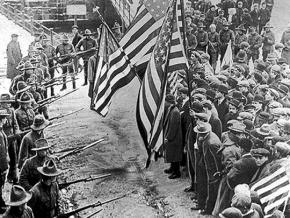Up from the ashes
A new book brings to life some of history's well-known and not-so-well-known labor struggles from around the world. reviews Live Working or Die Fighting.
IN LIVE Working or Die Fighting, Paul Mason describes in vivid detail the great battles of the early labor movement from 1819 to 1945.
Some of the battles are well known: the Paris Commune, the movement for the eight-hour day, the struggles of the Industrial Workers of the World (IWW), the Flint sit-down strikes of 1936. Others will be new even to those familiar with the history of the workers' movement: the battles for workers' control by the silk weavers of Lyon in France, the organizing of the Jewish Bund, Italy's Red Years in 1920-21.
As social history, this book stands alongside the great works of Howard Zinn or E.P. Thompson. It is an attempt to recapture a history that has been lost, even as the lessons from that history are more relevant than ever. As Mason puts it:
Today, the working class is bigger than it has ever been, is becoming more truly global. But its stories and narratives are lost. Lost, in part, because even in the West, the transmission mechanisms were broken during the defeat that shattered traditional working-class communities in the 1980s and '90s. But lost also because they were never truly told.

But what separates the book as a unique work is Mason's journalistic instincts to find the human stories at the heart of great historical events. Mason tells his story through the eyes of those who participated in it. He has uncovered firsthand accounts of both some of the movement's best-known leaders, such Big Bill Haywood of the IWW, anarchist union organizer August Spies and British syndicalist leader Tom Mann.
Throughout the various struggles, the central role of radicals, socialists, communists and anarchists is clear. But he has also included the accounts of otherwise anonymous participants in these momentous battles.
His description of the Chinese Revolution of 1927 covers the history of the early Chinese Communist Party, the great upsurge of Chinese workers and the treachery of Stalin's capitulation to the nationalist Koumintang, which led to the defeat and massacre of the movement. But he also tells the story of Li Qi-Han, a young Communist activist sent to Shanghai to organize the workers there.
Li finds a young working class fresh from the countryside, exploited on one hand by both their Chinese bosses and foreign powers occupying China, and on the other by the criminal gangs that controlled what unions did exist.
In order to gain access to the workers, Li actually begins by joining one of the rival gangs, complete with a blood ritual. He goes on to organize a union that will eventually represent more than 300,000 workers.
THROUGHOUT THE book, ordinary people overcome tremendous odds to win the most basic dignities--and in the process, their eyes are opened to the possibility of a different world. Mason's description of the famous Bread and Roses Strike in Lawrence, Mass., is particularly moving.
He describes the challenge of organizing textile workers who were young, without experience in labor organizing, and divided among numerous immigrant groups consciously pitted against one another by the textile owners. And yet, they found a way to overcome the obstacles.
Strike meetings often lasted all night, because each contribution had to be translated into more than 25 languages. The name of the strike was a reference to the idea that the demands might be about basic things like money and bread, but the goal was to defend workers' dignity--their right to have the means and the time to experience beauty.
As a journalist at the time wrote:
It is the first strike I ever saw which sang. I shall not soon forget the curious lift, the strange sudden fire of the mingled nationalities at the strike meetings when they broke into the universal language of song. And not only at meetings did they sing, but in the soup houses and in the streets. I saw one group of women strikers who were peeling potatoes at a relief station suddenly break into the swing of [the anthem of the international workers' movement] The Internationale.
This isn't just history. Mason sees parallels between the early years of the labor movement and today. He begins each chapter with a short description of the challenges facing contemporary workers: union organizing in Nigeria, workers in the high-tech sweatshops of India, in the oil fields of Iraq, underground organizing in the industrial boomtowns of Southeast China.
Mason doesn't try to make one-to-one comparisons or draw neat and tidy lessons from the past. The idea that history simply repeats itself is a myth. The solutions to the challenges of organizing in the 21st century will have to be discovered by workers themselves. But there are precedents.
The working class has been divided, atomized and weak before. There have been times when the challenges seemed insurmountable. And then, usually at the moment when things looked bleakest, someone found a way forward.
Radicals who had been toiling away in obscurity found that they had a mass audience. And the dream of a world based on freedom, justice and equality, which had lay dormant for many years, suddenly seemed like a possibility.


